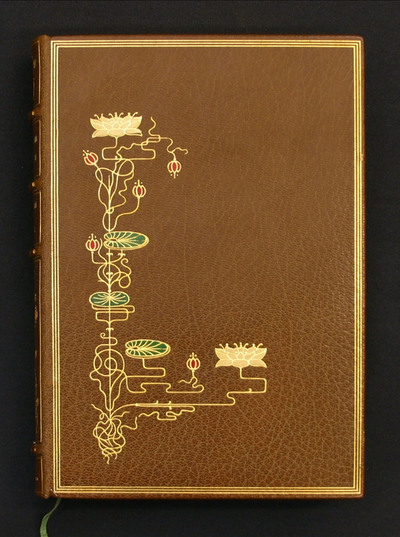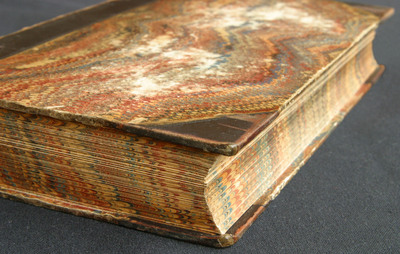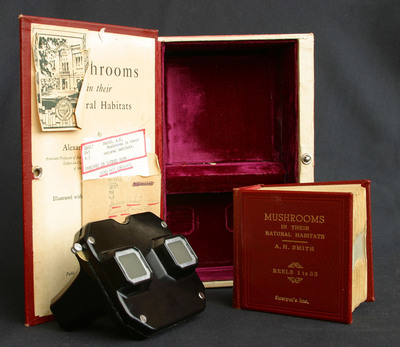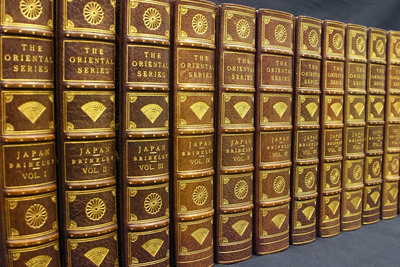As the codex became an increasingly accepted textual construct in the Western world, demand increased for the decorative adornment of books. Churches and monasteries were some of the first consumers of fine bindings, though the wealthy elite soon followed suit.
Decorative bookbinding was a complicated, inter-disciplinary trade. It required skills in leather, wood, and metalworking, a mastery of traditional binding techniques, and a great deal of facility with a variety of delicate tools. Early decorative bindings featured half-calf or full-calf boards covered with dampened leather and treated with a hot brass tool. This process, known as blind tooling, allowed the artisan to create impressions in the leather binding, leaving the desired image in relief.1 Later binders began introducing gold leaf into the process. Gold tooling came into prominence in Italy and Spain during the fifteenth century as a result of Arab influence in the Mediterranean and the Iberian Peninsula. Gold tooling required binders to create an impression (intaglio) of the desired image in the leather and then lay gold into the impression, creating an effect opposite of that caused by blind tooling.2
Binders also developed techniques for dying and adding texture to leathers, resulting in the relatively common levant morocco and turkey leathers, among others. Some binders experimented with a variety of exotic leathers including snake, crocodile, and even lion. In some exceptionally rare cases, books were bound in human skin, a process known as anthropodermic biblioplegy.
Some binders specialized in the use of valuable materials including rare stones, precious metals, silk, velvet, and other fine textiles. As demand for finely bound books increased, jewelers and metalsmiths found positions in binderies, providing the skill necessary to effectively use precious materials in the binding process. Of course the covers of books were not all that received the attention of binders. Some binderies began using high quality linen to cover the interior of their boards. Others employed velvet and silk. In the 17th century, Arabic traders brought a new decorative element to Europe—marbled paper3. The marbling process required dye to be carefully dropped across the surface of a liquid known as size. Designs were then made in the pools of dye using a stylus. Paper could then be laid across the top of the size and allowed to absorb some of the dye before being removed, dried, and treated with a protective coating. This process created paper with colorful, unique patterns frequently used to cover boards or serve as endpaper. Occasionally, the marbling was applied to the edges of the textblock for as an extra decorative element.
Bookbinding was a highly competitive craft well into the 20th century. Individual bookbinders became famous for their use of unique tools and techniques, and certain binderies enjoyed the patronage of wealthy landowners, politicians, and public figures. The art of fine bookbinding continues today, though the popularization of inexpensive "paperback" books and increasing emphasis on electronic media has reduced the industry.4
Notes
- Carter, John. ABC for Book-Collectors (England: Alfred A. Knopf, 1966), 40. Return to text ↑
- Nixon, Howard & Foot, Mirjam. The History of Decorate Bookbinding in England (Oxford, England: Oxford University press, 1992), 26-27. Return to text ↑
- Carter, John. ABC for Book-Collectors (England: Alfred A. Knopf, 1966), 131. Return to text ↑
- Lewis, Roy. Fine Bookbinding In the Twentieth Century (New York, NY: Arco, 1984). Return to text ↑

Gold tooling on levant morocco leather on a book cover. More images here.

Sample of feathered marbling on a cover and textblock. More images here

Container designed to look like a book. More images here

Gold-tooled book spine. More images here.
